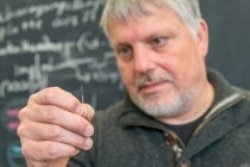Mar 16 2016
Researchers from the Ruhr-Universität Bochum have developed a new dry electrode that is capable of determining the concentration of certain positive ions in a stable and consistent way. This electrode can be produced cost-effectively on an industrial scale.
 Wolfgang Schuhmann develops micro-electrodes for ion concentration analysis.
Wolfgang Schuhmann develops micro-electrodes for ion concentration analysis.
The study, headed by Prof Dr Wolfgang Schuhmann from the Center of Electrochemical Sciences at the Ruhr-Universität Bochum, has been reported in the journal, Angewandte Chemie International Edition.
The concentration of specific ions has to be determined for industrial tests and blood analysis. Today’s applicable devices are large and are expensive to manufacture. The new dry electrode could resolve these issues. It is developed by simply printing a paste, and it could be smaller than 100 µm.
Mini analysis systems currently used to measure ion concentration have presented a number of issues to manufacturers, forcing them to make a compromise between costs, size, and reproducible results.
Analysis principle to date
Traditional ion-selective electrodes can only determine the concentration of positive ions, such as calcium, potassium, sodium, lithium, and magnesium ions. These electrodes have a membrane that is only permeable to the selected type of ions to be studied. Previously, an electrolyte solution included in the analysis system also contained the type of ions that needed to be studied.
The positively charged ions travel via the permeable membrane until their concentration becomes equal on either side. As they are positively charged, the electrical charge within the analysis system will vary from that of the examined liquid. The discrepancy in the electrical charge is then measured by a reference electrode submerged in the electrolyte solution. The concentration of the analyzed ions can be measured using the quantified results.
Selection of electrode material crucial
Designing a small version of this system would not provide adequate space for the electrolyte solution. However, Schuhmann’s team has identified a new way to develop an electrode that does not require the electrolyte solution. This approach still presented a challenge, particularly in the case of the electrodes that determine the concentration of ions which are positively charged.
The solution was surprisingly simple.
Dr Wolfgang Schuhmann, Professor, Center of Electrochemical Sciences, Ruhr-Universität Bochum
The researchers used a solid electrode material that is directly sensitive to the type of ions that are studied, instead of utilizing an electrolyte solution that contained the ion type that is studies. Lithium-iron-phosphate was used to detect lithium ions. This substance can temporarily store lithium ions and can emit them at a later time.
During the course of the present study, a 42-days test was performed that showed that the system is able to give consistent analysis results over a prolong time period.
We now have to search for other electrode materials with the capacity of storing other positively charged ions, such as sodium or potassium ions. Our progress so far has been encouraging.
Dr Wolfgang Schuhmann, Professor, Center of Electrochemical Sciences, Ruhr-Universität Bochum
The study was supported by the German Research Foundation under the umbrella of the Cluster of Excellence Resolv (EXC 1069).